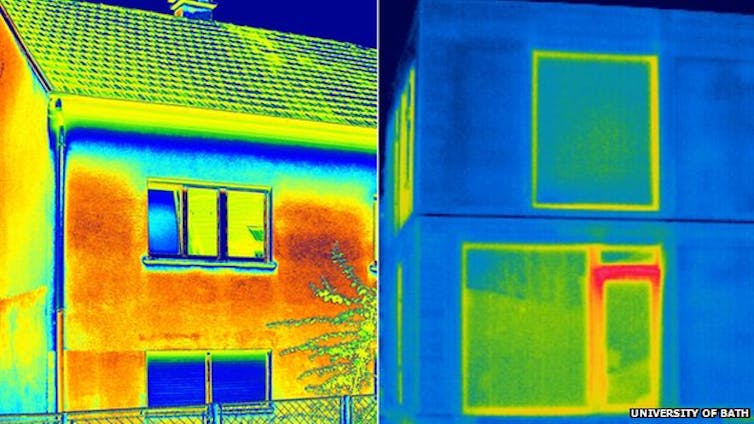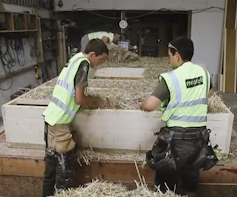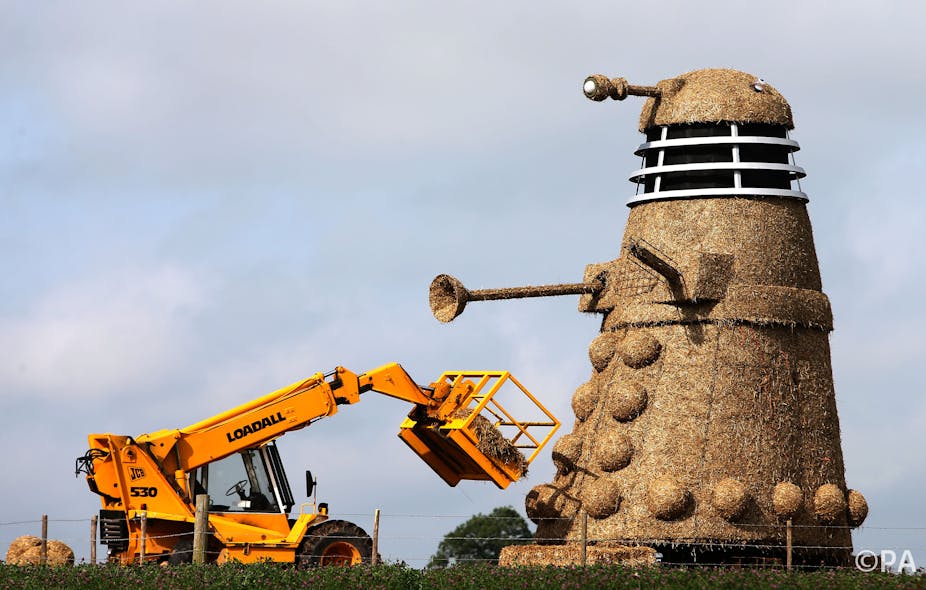Straw is cheap, good for the environment and an excellent insulator. So why don’t we see more straw houses? Unless we suddenly stop eating bread or cereal it’ll keep being produced anyway, and the excess straw in the UK alone could build a new city each year.
The UK construction sector must reduce its energy consumption by 50% and its carbon emissions by 80% by 2050, so radical changes are needed to the way we approach building houses. Straw could be a critical part of the transition towards a low-carbon future.
The thermal insulation value of a typical straw bale wall meets the requirements of even the most demanding performance specifications. Recent research led by the BRE Centre for Innovative Construction Materials at the University of Bath has shown that straw bale buildings reduce energy bills by 90% compared to conventional housing stock.
The manufacture of cement, used in concrete, is responsible alone for up to 8% of all industrially produced greenhouse gas emissions. Using natural materials such as straw, often directly from the field and with little further processing, significantly reduces this impact.

Traditionally, the environmental impact of construction materials has been significantly less than the impact of occupation (heating, cooling and so on) over the lifespan of the building. However, in modern energy efficient buildings the proportion attributable to that “embodied” in the fabric of the building is expected to increase to at least 90%. Measures to reduce the impact of the embodied energy and carbon will deliver even more environmentally friendly buildings.
A natural building material
Straw is just the dried stalks of plants stripped of their grain. You don’t really “make straw” – it’s a co-product of grain production, an established and essential agricultural process. So using straw doesn’t displace land required for essential food production.
In the UK more than 7m tonnes of straw remains after the production of wheat flour, and up to half this amount is effectively discarded due to its low value – simply chopped up and returned to the soil.
As an average three-bedroom house needs 7.2 tonnes of straw, the “leftover” could be used to build more than 500,000 new homes – a city the size of Birmingham could be built each year using discarded straw.
Straw is also a low-cost material. But more importantly, as a plant it captures and stores atmospheric carbon dioxide during photosynthesis. By using more and more straw in buildings we are creating a natural carbon storage bank.
Taking the huff and puff out of straw
Though the bible references using straw for bricks – and thatched roofs – have been common for centuries, modern straw construction was developed when mechanical baling machines were first used in late 19th-century Nebraska. Stacked like large bricks, straw bales can be used for modest loadbearing as well as non-loadbearing walls. The oldest surviving straw bale building is around 100 years old.
But straw has never caught on as an alternative to bricks, concrete or timber. There are concerns about its poor durability, fire resistance, the way it attracts mice and rats and, as one of the three little pigs found out the hard way, its lack of structural integrity.
Straw bales aren’t currently made to the same levels of tolerance and specification as bricks or cement. The fact they’re generally slightly different sizes combined with the need to keep bales dry during construction has meant most builders would not, until recently, consider straw bales a viable solution for anything. Other than perhaps for enthusiastic self-builders.
Straw goes mainstream
However, the development of prefabricated wall panels using straw bale for insulation has now provided the opportunity to market straw to the mainstream construction industry. Prefabrication, or off-site manufacture, means that wall panels can be made to a very high specification in a factory, protected from variable weather conditions that would otherwise inhibit on-site building with straw.

A prefabricated product can be certified as fit for use by industry bodies, making it much more acceptable to builders, financiers and insurers. It also radically reduces site construction times, with houses able to be erected in ten weeks instead of around 16 weeks for more conventional buildings. It seems the time has arrived for straw bale construction.
For the past ten years the University of Bath has been working with a local company, ModCell, to develop prefabricated straw bales. We started out looking at straw as a low-carbon cladding solution and soon moved on to developing panels that could bear heavy loads. Now, we are able to make low-energy prefabricated straw bale houses.
The panels have been subjected to fire tests, thermal transmittance tests, accelerated weathering tests, acoustic tests, simulated flooding and impact testing. We’ve even tested the structures in a simulated hurricane force wind, in what has been termed the “big bad wolf” test: the panels and prototype BaleHaus passed with flying colours.
These panels have now been granted certification. This in turn means insurers will cover straw houses and home-buyers will be able to obtain mortgages.
Hayesfield School in Bath, EcoDepot in York and the School of Architecture at the University of the West of England have all made use of these panels. Certification means the housing market can now use straw too, with LILAC in Leeds completed in 2013 and now a new development in Bristol due for completion later this year, with proposals for larger schemes already in planning.
Modern prefabricated straw bale houses are affordable, deliver excellent levels of energy efficiency in use for the home-owner or occupier and provide a genuine sustainable solution by using a cheap and widely available agricultural co-product. Other similar prefabricated systems using straw bale construction have been developed in Australia, Belgium and Canada. Entire communities, towns or even cities built from straw bales. And why not?

